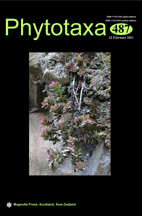Abstract
Pimpinella crispulifolia, a species known only from the holotype locality (Laoguishan of Shilin County) collected in 1906, was rediscovered in Luquan County of Kunming City, China. To examine its systematic position, a phylogenetic reconstruction was performed based on nrDNA internal transcribed spacer (ITS) region under the framework phylogeny of Apiaceae subfamily Apioideae. It showed an affinity to Sium species of Oenantheae. Morphological similarity is reflected in its fascicled roots, simple pinnate leaves, long and reflexed styles, and ovoid, laterally compressed fruits with prominent and corky-thickened ribs. Therefore, a new combination of Sium crispulifolium (H.de Boissieu) J. Zhou is proposed with full taxonomic treatments. Its morphological description is also amended and completed with both living individuals and newly collected specimens.

